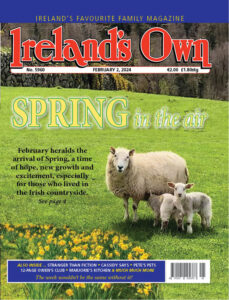February heralds the arrival of Spring, a time of hope, new growth and excitement, especially for those who lived in the Irish countryside, writes John Corbett
Nothing is so beautiful as Spring,
When weeds, in wheels, shoot long and lovely and lush.
Those are the opening lines of a poem entitled Spring by Gerard Manley Hopkins.
February, the shortest month of the year, heralds the arrival of Spring. It’s a latecomer, only appearing in 700 BC when the old Roman calendar was changed. Up to that time there were just ten months in a year. Then January and February were added to give us our present count of twelve.
February has twenty-eight days, but as you know, it’s given an extra one, called Leap Day, every four years to make the regular calendar equal to the solar one. This happened in 45 BC with the adoption of the Julian Calendar. This year (2024) is a Leap Year.
 According to tradition, it’s a woman’s privilege to propose to her lover in a Leap Year. Other than that, it’s generally left to males to offer proposals of marriage.
According to tradition, it’s a woman’s privilege to propose to her lover in a Leap Year. Other than that, it’s generally left to males to offer proposals of marriage.
The flowers associated with February are violets and primroses. Tulips are plentiful at this time of year also. Tulips from Amsterdam was a big hit for Max Bygraves when we were going to school.
OLD CUSTOMS
February gets its name from Februus, the Roman God of purification. Cleansing was an important feature of life for our early ancestors. They believed that bad luck would follow if they didn’t observe the rules, as they saw them.
The Celts used to sacrifice a cockerel to the sun on the first of the month. This was generally done at a crossroads or at the confluence of two rivers.
Another practice was for individuals to bathe their faces in the morning dew to preserve their youth. This was a common practice on May Morning too.
Elders paid particular attention to weather omens, tides, or other lore relating to the coming year. This is understandable because back then working methods were basic, so those depending on the soil wanted to figure out the best modes to produce a bountiful return later in the year.
March, the second month of Spring, is named after Mars, the Roman God of War. It has been called ‘March of many weathers’ and is reputed to ‘Come in like a lion and go out like a lamb.’ In former times March 1 was New Year’s Day.
St. Patrick’s Day is on March 17 when Irish people all over the world organise marches and various other events to mark the occasion.
April derives from a Latin name for a girl, meaning to open or to blossom. It was noted for its mild weather.
Sometimes an April day
Will suddenly bring showers,
Rain to grow the flowers
For her first bouquet.
They are the opening lines from April Love recorded by Pat Boone in the Sixties. We felt that the dark days of winter were well and truly over as the month advanced.
Continue reading in this week’s Ireland’s Own


